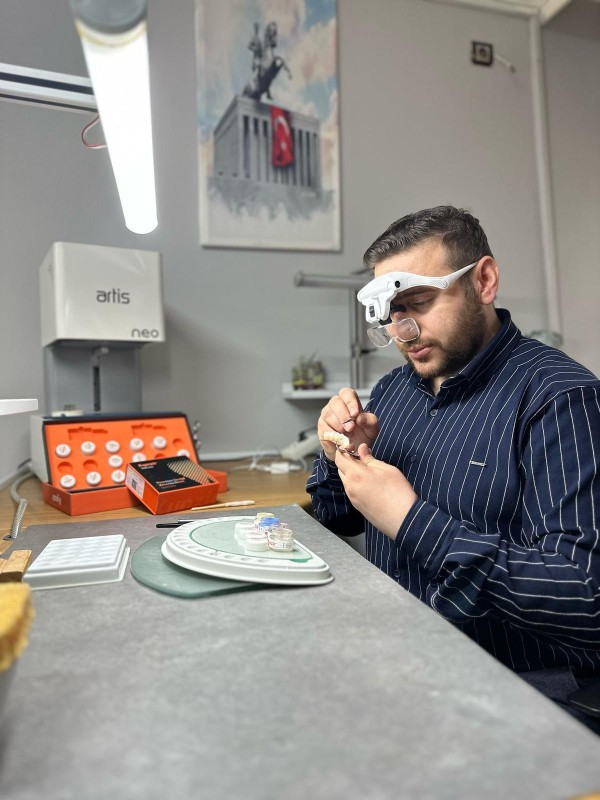

Achieving a Natural Appearance with Zirconium Teeth
Kyozir Zirconia Blocks:
Kyozir Zirconia Blocks are materials with high strength, biocompatibility, and a variety of color options that provide patients with long-lasting functional smiles. They are among the most aesthetic and most preferred materials in today’s dental industry. Excellent results are achieved with Kyozir Blocks.
Form and Anatomical Structure:
The shape and contour of teeth should be compatible with the patient’s face type, jaw structure, age, and gender. The size and width of the teeth should be determined according to the patient’s facial features. For example, wider and rounder teeth are preferred for individuals with long faces, while thinner and longer teeth are preferred for those with round faces. The incisal edges and corner structure of the teeth should mimic the irregularity of natural teeth. Prosthetic teeth with completely symmetrical and sharp lines can appear artificial. Slight rotations and angle differences in the front teeth help achieve a more natural appearance. According to the patient’s chewing habits and functional requirements, indentations and protrusions on the chewing surfaces should be modeled in accordance with natural tooth structure.
Texture and Surface Roughness:
The surface of real teeth is not completely smooth; there are fine grooves, indentations, and rough textures. These features help teeth reflect light naturally, providing a more realistic, natural appearance. Matte and shiny areas should be distributed evenly. Excessively glossy and glass-like teeth appear artificial. As age progresses, wear and linear structures on the tooth surface increase. Considering this factor, age-appropriate surface textures are created, enhancing the natural appearance. Rather than creating a completely smooth and glossy surface during the finishing process, subtle micro-textures are intentionally left to mimic natural tooth surfaces.
Tooth Cutting and Gingival Adaptation in Zirconia Restorations:
In monolithic restorations prepared with CAD/CAM technology, achieving high-precision preparation during tooth cutting offers a significant advantage. When digital measurement is used instead of traditional methods, preparation errors are minimized, and the restoration’s adaptation to the gum becomes more successful. Sharp edges can create a risk of breakage, so all edge transitions should be rounded. Softer angles should be preferred during cutting.
Chamfer or Shoulder Margin:
In monolithic restorations, chamfer (rounded edge) or shoulder (step-like margin) cutting is preferred to provide better adaptation to the gum line. Instead of sharp edges, a margin with smooth transitions increases compatibility with the gum.
Subgingival (Below the Gum) Margin:
If the patient’s aesthetic expectations are high, the edges of the restoration can be placed slightly below the gum line. However, for maintaining gum health, this area must be polished well and kept smooth.
Supragingival (Above the Gum) Margin:
If the patient has sensitive gums, the margin line is left slightly above the gum level. This approach protects gum health and reduces the risk of gum recession over the long term.
Makeup and Coloring:
If there is a color difference between the selected tooth color and the zirconia, natural makeup can be applied to match the missing pigments. For intermediate colors not found in the color scale or situations where multiple colors are present in a single tooth, we try to achieve the desired colors through our makeup set and creative solutions.
Incisal Coloring: Shades such as Blue, White, Grey, and Transparent are used to replicate the natural translucency and gradient effect of real teeth.
Layering Technique:
Natural teeth are composed of different layers such as enamel, dentin, and pulp. This structure is reconstructed layer by layer in prosthetic teeth to achieve a natural appearance.
1. Dentin Layer: The internal structure of the tooth is formed first. Since dentin gives the tooth its primary color, selecting the correct tone is essential.
2. Enamel Layer: Applied over the dentin, the enamel layer should be transparent and semi-translucent to allow natural reflection of the underlying colors.
Staining Technique:
The staining technique is an advanced method used to achieve a natural tooth appearance, especially in monolithic zirconia or ceramic restorations. In this technique, various pigments are applied to the surface of the tooth to create realistic color tones, stains, and light reflections seen in natural teeth.
1. Base Coloring: The main color of the prosthetic tooth is determined, and a base coloring is applied. Natural teeth do not have uniform color; different tones are found in the enamel and dentin areas. This diversity is detailed through the staining method.
2. Detailing: Blue or gray tones are used at the tooth’s tips to create natural translucency effects. Slight yellowish or brownish tones are added to the cervical area to mimic aging and natural wear. Chewing surfaces are shaded with brown tones to replicate natural usage marks.
3. Firing Process: The firing process involves heating the pigments to specific temperatures to ensure their permanence. The required firing time and temperature depend on the type of zirconia or ceramic material being used.
The staining technique prevents teeth from appearing artificial by creating custom shades and providing a natural appearance unique to the individual.




